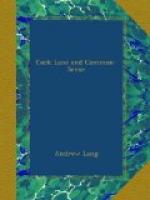Modern times have known dream-evidence in cases of murder, as in the Assynt murder, and the famous Red Barns affair. But Thomas Harris’s is probably the last ghost cited in a court of law. On the whole, the ghosts have gained little by these legally attested appearances, but the trials do throw a curious light on the juridical procedure of our ancestors. The famous action against the ghosts in the Eyrbyggja Saga was not before a Christian court, and is too well known for quotation. {273}
A MODERN TRIAL FOR WITCHCRAFT
Thorel v. Tinel. Action for libel in 1851. Mr. Dale Owen’s incomplete version of this affair. The suit really a trial for witchcraft. Spectral obsession. Movements of objects. Rappings. Incidental folklore. Old G. Thorel and the cure. The wizard’s revenge. The haunted parlour boarder. Examples of magical tripping up, and provoked hallucinations. Case of Dr. Gibotteau and Berthe the hospital nurse. Similar case in the Salem affair, 1692. Evidence of witnesses to abnormal phenomena. Mr. Robert de Saint Victor. M. de Mirville. Thorel non-suited. Other modern French examples of witchcraft.
Perhaps the last trial for witchcraft was the case of Thorel v. Tinel, heard before the juge de paix of Yerville, on January 28, and February 3 and 4, 1851. The trial was, in form, the converse of those with which old jurisprudence was familiar. Tinel, the Cure of Cideville, did not accuse the shepherd Thorel of sorcery, but Thorel accused Tinel of defaming his character by the charge of being a warlock. Just as when a man prosecutes another for saying that he cheated at cards, or when a woman prosecutes another for saying that the plaintiff stole diamonds, it is really the guilt or innocence of the plaintiff that is in question, so the issue before the court at Yerville was: ‘Is Thorel a warlock or not?’ The court decided that he himself had been the chief agent in spreading the slander against himself, he was non-suited, and had to pay costs, but as to the real cause of the events which were attributed to the magic of Thorel, the court was unable to pronounce an opinion.
This curious case has often been cited, as by Mr. Robert Dale Owen, in his Footfalls on the Boundary of Another World, {275} but Mr. Owen, by accident or design, omitted almost all the essential particulars, everything which connects the affair with such transactions as the witch epidemic at Salem, and the trials for sorcery before and during the Restoration. Yet, in the events at Cideville, and the depositions of witnesses, we have all the characteristics of witchcraft. First we have men by habit and repute sorcerers. Then we have cause of offence given to these. Then we have their threats, malum minatum, then we have evil following the threats, damnum secutum. Just as of old, that damnum, that damage, declares itself in the ‘possession’ of young people,




